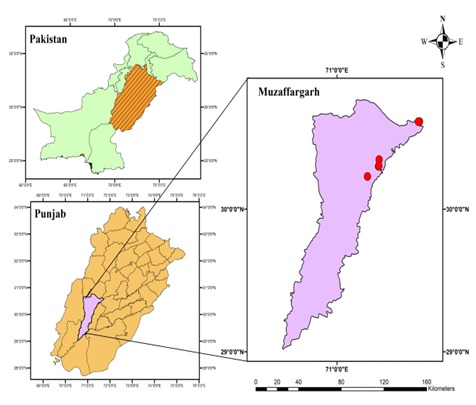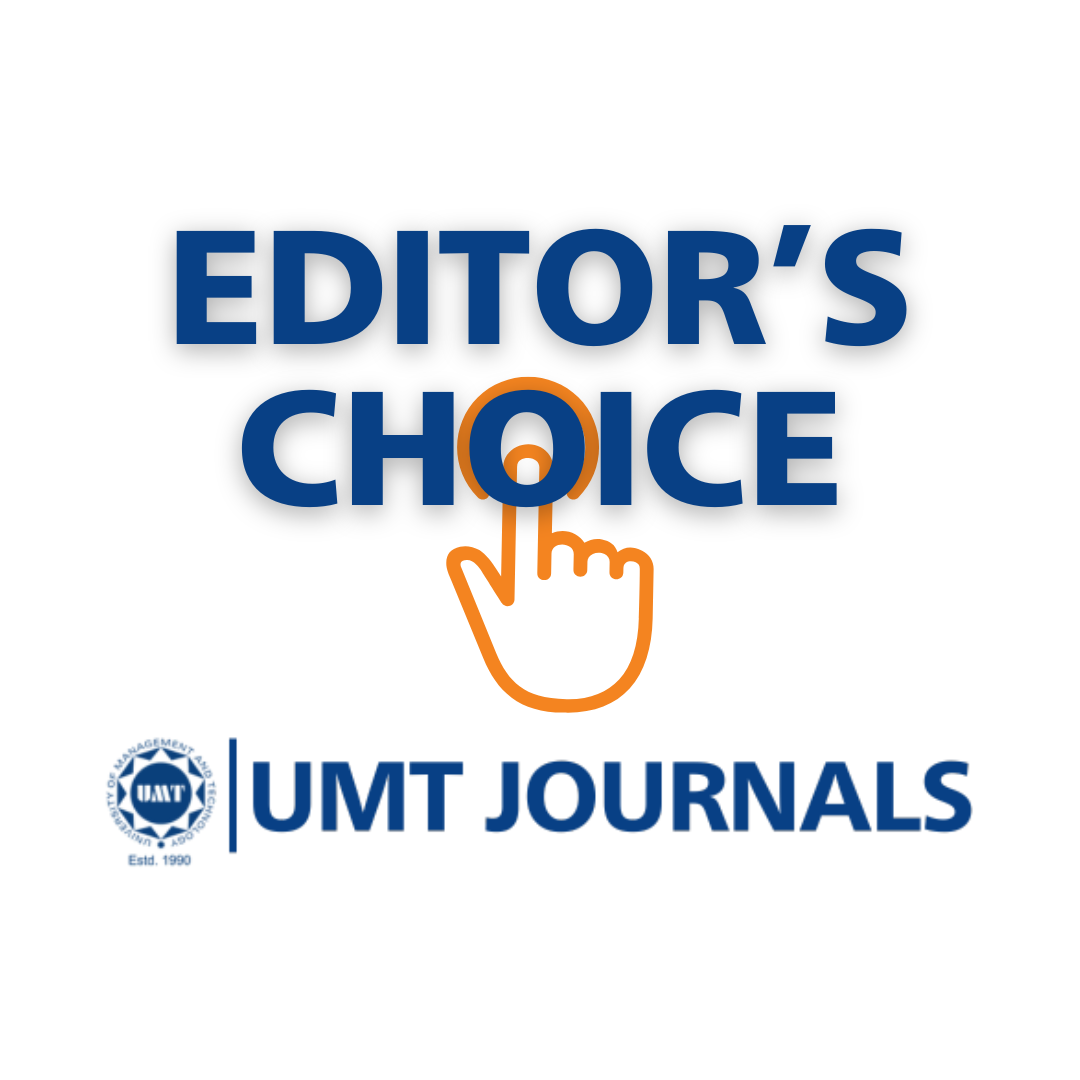Epidemiology and Molecular Confirmation of E. coli Isolated from Diseased Fish in Muzaffargarh, Punjab, Pakistan
Abstract
 Abstract Views: 0
Abstract Views: 0
Background Fish is an important source of protein and vitamins, such as vitamin D and B2 (riboflavin) for human beings. However, they are plagued with a variety of disease-causing pathogens, resulting in significant economic losses. Among these pathogens, Escherichia (E.) coli are prominent, worldwide. This study aimed to conduct epidemiological surveillance and identification of E. coli strains isolated from diseased fish in District Muzaffargarh, Punjab, Pakistan.
Methodology A total of fifty (50) diseased fish samples were collected from various fish farms in the district. The isolation process involved enriching the samples in nutrient broth and incubating them at 37°C for 24 hours. After enrichment, the samples were inoculated on MacConkey agar and incubated again at 37°C for 24 hours. Following incubation, Gram staining was performed to identify E. coli and confirm its presence. These isolates were subjected to PCR using the uspA gene for confirmation.
Results Among fish diseases, Hemorrhagic septicemia was reported to have the highest prevalence (22%), while 12% of fish samples were infected with abdominal dropsy and fin rot. In total, six (06) E. coli isolates were obtained from five different diseased fish samples and confirmed by PCR-based detection of uspA gene.
Conclusion The current study found a link between disease-affected fish and naturally occurring E. coli, with molecular confirmation using the uspA gene. Effective management of soil, stock, water, nutrition, and environment is crucial to control losses caused by E. coli as opportunistic fish pathogens and spoilage agents.
Downloads
References
Thampuran N, Surendraraj A, Surendran PK. Prevalence, and characterization of typical escherichia coli from fish sold at retail in Cochin. India J Food Prot. 2005;68(10):2208–2211. https://doi.org/10.4315/0362-028X-68.10.2208
Govind P, Shrivastav AB, Sharma M. Fishes of Madhya Pradesh with special reference to zebrafish as a model organism in biomedical research. Int Res J Pharm. 2012;3:120–123.
Laghari MY. Aquaculture in Pakistan: challenges and opportunities. Int J Fish. 2018;6(2):56–59.
Nazir K, Yongtong M, Hussain K, Kalhoro MA, Kartika S, Mohsin M. A study on the assessment of fisheries resources in pakistan and its potential to support marine economy. Ind J Geo-Mar Sci. 2016;45(9):1181–1187.
Lipp EK, Rose JB. The role of seafood in foodborne diseases in the United States of America. Rev Sci Tech OIE. 1997;16:620–640. https://doi.org/10. 20506/rst.16.2.1048
Håstein T, Gudding R, Evensen Ø. Bacterial vaccines for fish – an update of the current situation worldwide. Dev Biol. 2005;121:55–74.
Petronillah R, Robert K, John V, Nyoni S. Isolation and identification of pathogenic bacteria in edible fish: a case study of fletcher dam in Gweru, ZimbabweInt. J Sci. 2013;2:269–273.
Sallam K. Chemical, sensory and shelf-life evaluation of slice salmon treated with salts of organic acids. J Food Chem. 2007;2:592–600. https://doi.org/10.1016/j.foodchem.2006.02.019
Abowei J, Briyai O. A review of some bacteria diseases in Africa culture fisheries. Asian J Med Sci. 2011;3:206–217.
Rodricks EG. Indigenous pathogen: vibrionaceae. In: Ward DR, Hackney CA, eds. Microbiology of Marine Food Products. New York: Springer;1991:285–295.
Austin B, Austin DA, Munn CB. Bacterial Fish Pathogens: Disease of Farmed and Wild Fish. Chichester: Springer; 2007.
Austin B, Alsina M, Austin DA, et al. Identification and typing of Vibrio anguillarum: a comparison of different methods. Syst Appl Microbiol. 19951;18(2):285–302. https://doi.org/ 10.1016/S0723-2020(11)80400-5
Tchaptchet S, Hansen J. The yin and yang of a host-commensal mutualism. Gut Microbes. 2011;2:347–352. https://doi.org/10.4161/gmic.19089
Geldrich EE. Sanitary Significance of Fecal Coliforms in The Environment (Water Pollution Control Research Series). Cincinnati, Ohio: U. S. Department of Interior; 1966.
Levine MM. Escherichia coli that cause diarrhea: enterotoxigenic, enteropathogenic, enteroinvasive, enterohemorrhagic and enteroadherent. J Infect Dis. 1987;155:377–389. https://doi.org/ 10.1093/infdis/155.3.377
Wan KF, Son R, Cheah YK, Patrick GB, Michael CM. Antibiotic resistance, plasmid profile and RAPD-PCR analysis of enteropathogenic Escherichia coli (EPEC) clinical isolates. Asian J Trop Med. 2003;34:620–626.
Lynch M, Painter J, Woodruff R, Braden C. Surveillance for foodborne disease outbreaks United States, 1998–2002. National Center for Infectious Diseases (U.S.). https://stacks.cdc. gov/view/cdc/6778
Shiklomanov A. Appraisal and assessment of world water resources. Water Int. 2000;25(1):11–32. https://doi.org/10.1080/02508060008686794
James CE, Stanley KN, Allison HE. et al. Lytic and lysogenic infection of diverse Among a list E. coli and Shigella strains with a verotoxigenic bacteriophage. J Appl Environ Microbiol. 2001;67:4335–4337. https://doi.org/10.1128/AEM.67.9.4335-4337.2001
Bokhari H, Shah MA, Asad S, Akhtar S, Akram M, Wren BW. Escherichia coli pathotypes in Pakistan from consecutive floods in 2010 and 2011. Am J Trop Med. 2013;88(3):519–525. https://doi.org/10.4269/ajtmh.12-0365
Jamil J, Haroon M, Sultan A, Khan MA, Gul N. Prevalence, antibiotic sensitivity, and phenotypic screening of ESBL/MBL producer E. coli strains isolated from urine; District Swabi, KP. Pakistan. J Pak Med Assoc. 2018;68(11):1704–1707.
Kljujev I, Raicevic V, Andrews S, Jackson R, Lalevic B, Dorati F. Transmission of E. coli from contaminated irrigation water and soil to plant tissue. J Hyg Eng Design. 2012;11:83–87.
Waturangi DE, Hudiono F, Aliwarga E. Prevalence of pathogenic escherichia coli from salad vegetable and fruits sold in Jakarta. BMC Res Notes. 2019;12(1):1–9. https://doi. org/10.1186/s13104-019-4284-2
Khan AA, Shah MA. Marbled teal breeding in Punjab, Pakistan. TWRG News. 1993;4(7).
Ali S, Akhter S, Muhammad A, et al. Identification, characterization, and Antibiotic sensitivity of aeromonas hydrophila, a causative agent of epizootic ulcerative syndrome in wild and farmed fish from Potohar. Pak J Zool. 2016;48(3):899–901.
Divya PS, Paul S, Fathima PA, Abdulla MH. Comparative evaluation of EMB agar and hicrome E. coli agar for differentiation of green metallic sheen producing non E. coli and typical E. coli colonies from food and environmental samples. J Pure Appl Microbiol. 2016;10(4):2863–2870. http://dx.doi.org/10.22207/JPAM.10.4.48
Godambe LP, Jayant B, Ravindranath S. Species specific PCR based detection of Escherichia coli from Indian foods. 3 Biotech. 2017;7:e130. https://doi.org/10.1007/s13205-017-0784-8
Oliveira RV, Oliveira MC, Pelli A. Disease infection by enterobacteriaceae
family in fishes. J Microbiol Exp. 2017;4(5):e00128.
Ristori CA, Iaria ST, Gelli DS, Rivera ING. Pathogenic bacteria associated
with oysters (Crassostrea brasiliana) and estuarine water along the south coast of Brazil. Int J Environ Health Res. 2007;17(4):259–269. https://doi. org/10.1080/09603120701372169
Sousa CP. The versatile strategies of escherichia coli pathotypes: a mini review. J Venom Anim Toxins Incl Trop Dis. 2006;12(3):363–373.
Ekici G, Dumen E. Escherichia coli and food safety. In: Erjavec MS, ed. The Universe of Escherichia Coli. Book on Demand; 2019.
Marijani E. Prevalence and antimicrobial resistance of bacteria isolated from marine and freshwater fish in Tanzania. Int J Microbiol. 2022;2022(4):e4652326. https://doi. org/10.1155/2022/4652326
Elbaz NF, Abd Al Fatah ME. Bacterial diseases outbreaks in some freshwater fish farms in Kafr El-Sheikh, Egypt. J Appl Aquac. 2022;29:1–23. https://doi. org/10.1080/10454438.2022.2105673
Saharia PK, Kalita B, Hussain IA, et al. Prevalent Fish diseases in the carp polyculture system of Assam. J Krishi Vigyan. 2020;9:218–224. https://doi. org/10.5958/2349-4433.2020.00112.9
Rehman J, Kamboh AA, Moryani AA, et al. Prevalence and antimicrobial susceptibility of bacterial organisms in raw fish of pond and retail market. J Anim Health Prod. 2023;11(3):258–266. http://dx.doi.org/10.17582 /journal.jahp/2023/11.3.258.266
Dissasa G, Lemma B, Mamo H. Isolation, and identification of major bacteria from three Ethiopian rift valley lakes live and processed fish, and water samples: implications in sanitary system of fish products. BMC Vet Res. 2022;18(1):e439. https://doi. org/10.1186/s12917-022-03508-w
Tilahun A, Engdawork A. Isolation, identification, and antimicrobial susceptibility profile of E. coli (O157: H7) from fish in lake Hawassa, southern Ethiopia. Life Sci J. 2020;17:64–72.
Onmaz NE, Yildirim Y, Karadal F, et al. Escherichia coli O157 in fish: prevalence, antimicrobial resistance, biofilm formation capacity, and molecular characterization. LWT. 2020;1:e109940. https://doi.org/10. 1016/j.lwt.2020.109940
Yagoub S. Isolation of enterobacteriaceae and pseudomonas spp. from raw fish sold in fish market in Khartoum state. J Bacteriol. 2009;7:85–88.
Munekata PE, Pateiro M, Rodríguez-Lázaro D, Domínguez R, Zhong J, Lorenzo JM. The role of essential oils against pathogenic Escherichia coli in food products. Microorganisms. 2020;8(6):e924. https://doi.org/10. 3390/microorganisms8060924
Hardiati A, Wibawan IW. Resistance of ampicillin, ceftazidime, and cefotaxime in poultry’s escherichia coli. J Riset Veter Indon. 2023;7(1):1–10. https://doi.org/10.20956/ jrvi.v7i1.23766

Copyright (c) 2024 Ahmad Hassan

This work is licensed under a Creative Commons Attribution 4.0 International License.
BSR follows an open-access publishing policy and full text of all published articles is available free, immediately upon publication of an issue. The journal’s contents are published and distributed under the terms of the Creative Commons Attribution 4.0 International (CC-BY 4.0) license. Thus, the work submitted to the journal implies that it is original, unpublished work of the authors (neither published previously nor accepted/under consideration for publication elsewhere). On acceptance of a manuscript for publication, a corresponding author on the behalf of all co-authors of the manuscript will sign and submit a completed the Copyright and Author Consent Form.









